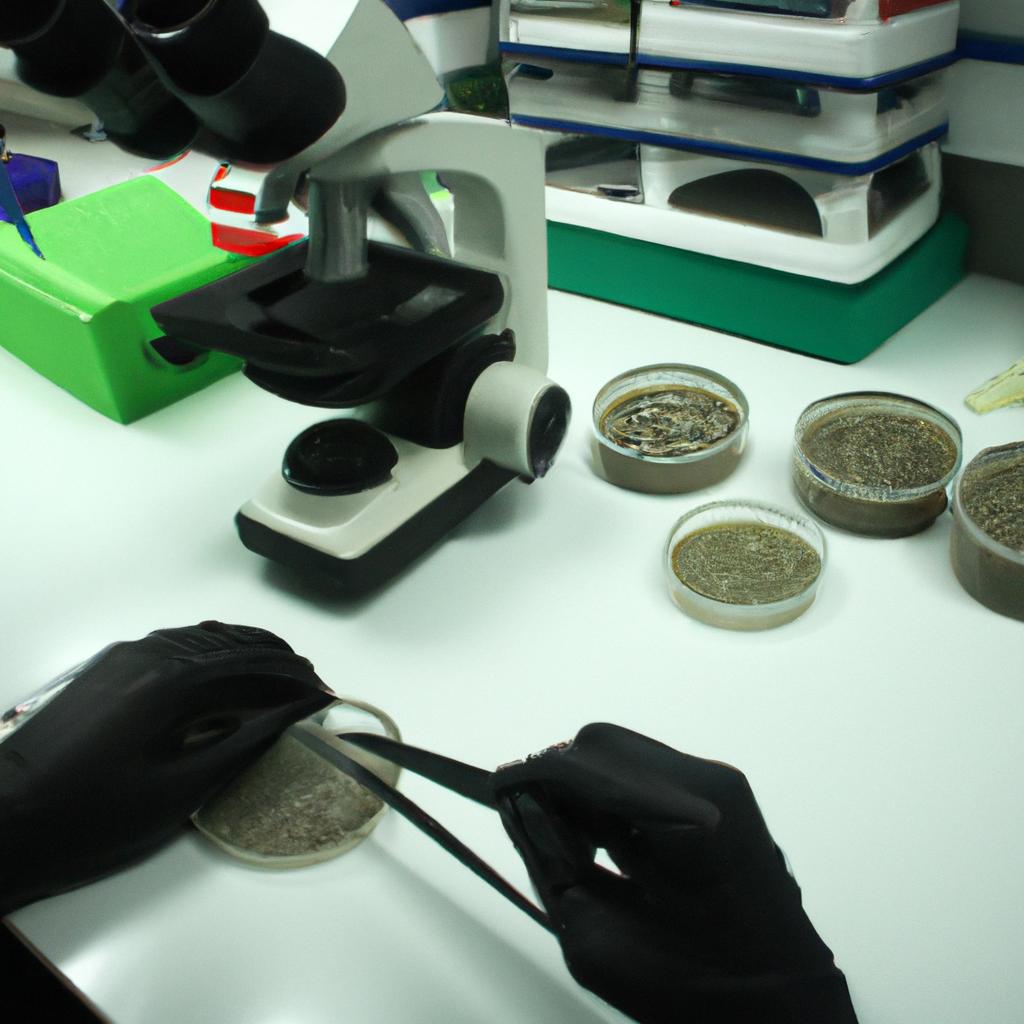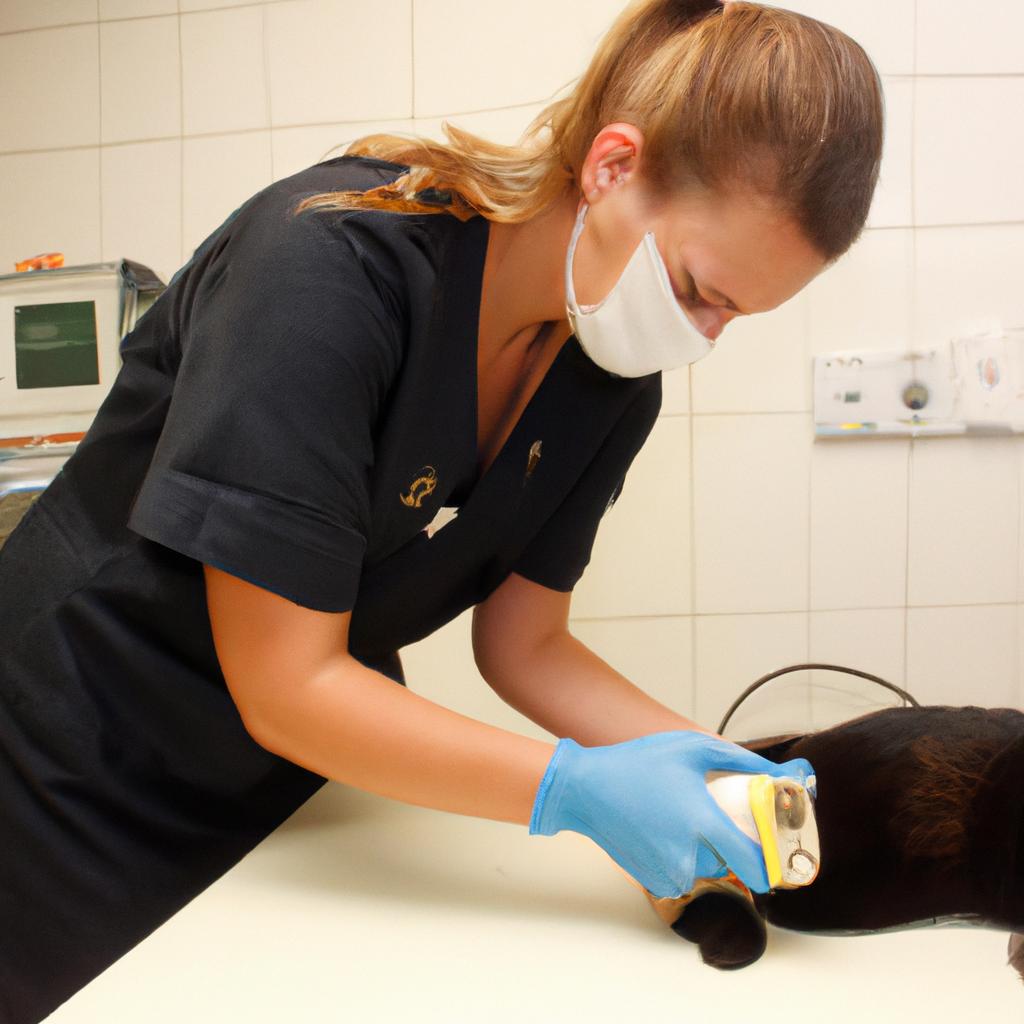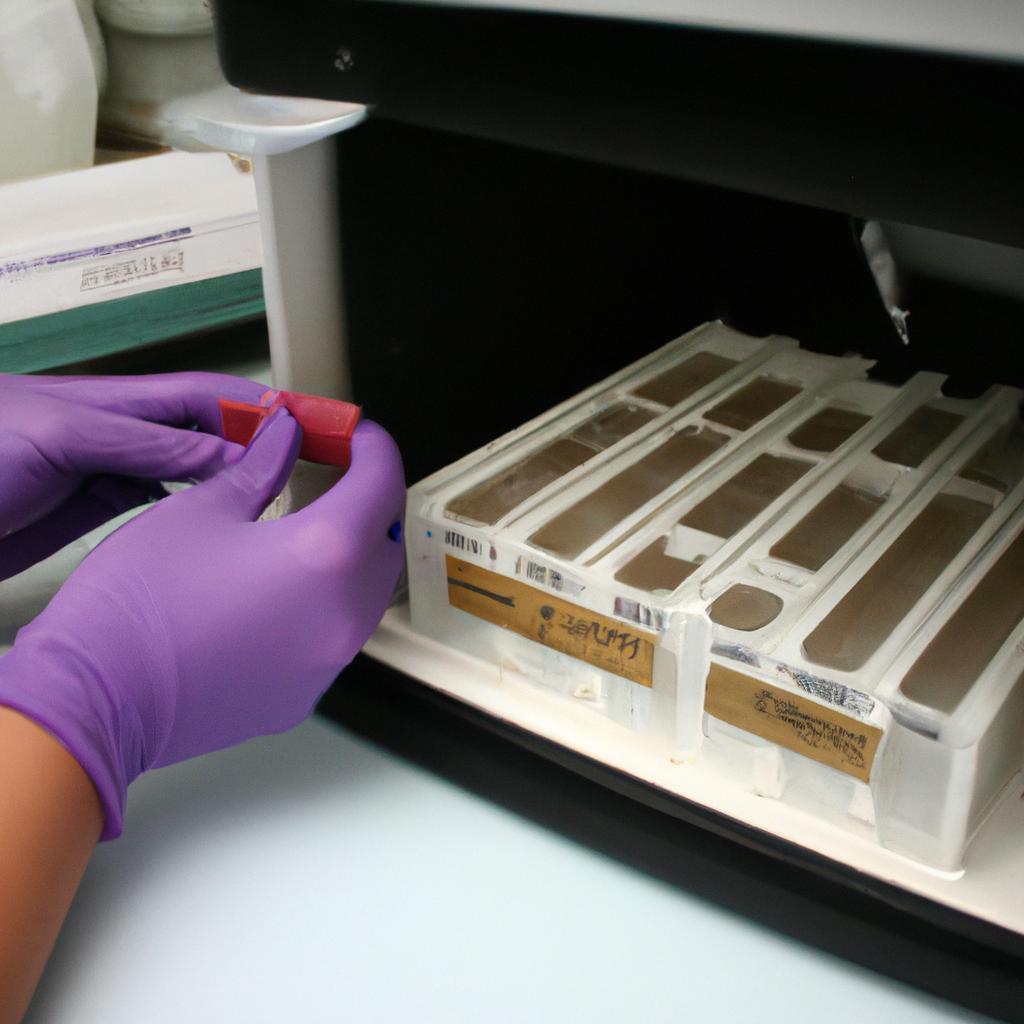Ectoparasites, such as fleas and ticks, have long plagued both domesticated animals and their human companions. These external parasites not only cause discomfort to the host but can also transmit a wide range of diseases. Veterinary clinical pathology plays a crucial role in diagnosing and managing these parasitic infestations. For instance, consider a hypothetical case involving a dog presenting with intense itching and skin lesions. Through meticulous examination and laboratory analysis of blood samples, veterinary clinical pathologists can identify the specific ectoparasite responsible for the condition, ascertain the extent of infestation, and provide appropriate treatment strategies.
The field of parasitology encompasses the study of various organisms that live on or within another organism (the host) at its expense. Ectoparasites are particularly interesting from both biological and medical perspectives due to their direct interaction with hosts’ external surfaces. Dermatological manifestations caused by ectoparasites pose significant challenges to veterinarians who specialize in clinical pathology. By adopting an academic approach that focuses on objective data collection, interpretation, and precise disease diagnosis, veterinary professionals can effectively address the complexities associated with ectoparasitic infections in animal populations. This article delves into the importance of veterinary clinical pathology in understanding parasitology specifically in relation to ectoparasites and their impact on animals.
Veterinary clinical pathology plays a crucial role in understanding the field of parasitology, particularly when it comes to ectoparasites. Ectoparasitic infestations can have various effects on animals, ranging from mild irritation to severe health issues. By utilizing laboratory analysis techniques, veterinary clinical pathologists can accurately diagnose the presence of specific ectoparasites in animals.
One primary aspect of veterinary clinical pathology is identifying the specific ectoparasite responsible for the condition. Through meticulous examination and analysis of blood samples or skin scrapings, pathologists can detect the presence of fleas, ticks, mites, lice, or other external parasites. This identification is essential because different ectoparasites require different treatment approaches.
In addition to identifying the parasite species, veterinary clinical pathology also helps determine the extent of infestation. By examining blood samples for signs of anemia or conducting skin scrapings to assess the number of parasites present, pathologists can gauge how severely an animal is affected by ectoparasitic infestation. This information is vital for developing appropriate treatment strategies and determining the prognosis for infected animals.
Furthermore, veterinary clinical pathology contributes to understanding the potential complications associated with ectoparasitic infections. Some ectoparasites can transmit diseases to their hosts through bites or direct contact. Veterinary pathologists play a crucial role in detecting these transmitted diseases through laboratory analysis and providing insights into their severity and potential impacts on animal health.
Overall, veterinary clinical pathology is instrumental in diagnosing and managing ectoparasitic infestations in animals. By thoroughly examining blood samples and conducting specialized tests, pathologists can identify specific parasites, assess the extent of infestation, and provide valuable information regarding associated diseases. This knowledge enables veterinarians to develop effective treatment plans that alleviate discomfort in affected animals while addressing any underlying health concerns caused by these troublesome external parasites.
Overview of Ectoparasites in Veterinary Medicine
Imagine a dog named Max, who loves exploring the outdoors. One day, his owner notices that Max is constantly scratching and biting at himself. Upon closer examination, they discover tiny creatures crawling on his fur. These external parasites, known as ectoparasites, are a common occurrence in veterinary medicine.
Ectoparasites are organisms that live on the outer surface of their host’s body and rely on them for survival. They encompass a wide range of arthropods such as fleas, ticks, mites, lice, and flies. In addition to causing discomfort and irritation to animals like Max, ectoparasites can transmit diseases and cause various dermatological conditions.
Understanding the impact of ectoparasites on veterinary medicine is crucial for effective diagnosis and treatment. Here are some key points to consider:
- Prevalence: Ectoparasitic infestations are prevalent worldwide among both domesticated pets and livestock. Factors such as climate, geographical location, animal density, and poor hygiene practices contribute to their spread.
- Clinical Manifestations: The presence of ectoparasites can lead to an array of clinical signs including pruritus (itching), alopecia (hair loss), erythema (redness), papules (small raised bumps), or even secondary bacterial infections due to self-inflicted trauma.
- Disease Transmission: Many ectoparasites act as vectors for infectious agents responsible for zoonotic diseases affecting both animals and humans. Examples include Lyme disease transmitted by ticks or flea-borne typhus caused by Rickettsia bacteria.
- Control Strategies: To prevent or manage ectoparasite infestations effectively, veterinarians employ several control strategies ranging from topical treatments with insecticides/acaricides to environmental management measures targeting breeding sites or habitat modification.
To illustrate further how different ectoparasites impact veterinary medicine, the table below provides a summary of selected ectoparasitic diseases and their associated vectors:
| Ectoparasite | Disease Transmitted | Host Species |
|---|---|---|
| Fleas | Dipylidium caninum (tapeworm) | Dogs and cats |
| Ticks | Lyme disease, Anaplasmosis, Babesiosis | Various mammals including humans |
| Mites | Sarcoptic mange, Demodicosis | Dogs |
| Lice | Pediculosis | Cattle, horses, dogs |
In conclusion, understanding ectoparasites’ prevalence, clinical manifestations, disease transmission potential, and control strategies is essential for veterinarians to effectively diagnose and manage these infestations. In the subsequent section about “Identification and Classification of Ectoparasites,” we will delve deeper into the steps involved in recognizing different types of ectoparasites.
Identification and Classification of Ectoparasites
Imagine a scenario where a dog owner notices that their pet is incessantly scratching its ears. Upon closer examination, they discover tiny insects crawling on the dog’s skin. This situation highlights the importance of identifying and classifying ectoparasites in veterinary medicine. By understanding the unique characteristics and classifications of these parasites, veterinarians can effectively diagnose and treat infestations.
To identify ectoparasites accurately, veterinarians employ various techniques. One commonly used method involves microscopic examination of samples collected from affected areas. For instance, a sample could be taken by scraping off some skin scales or collecting hair follicles with attached parasite specimens. Microscopic analysis allows for the identification of specific morphological features, such as body shape, mouthparts, or specialized structures like claws or spines.
The classification of ectoparasites is based on different criteria including taxonomic groups and host preference. Taxonomically, ectoparasites are categorized into various classes (e.g., Arachnida), orders (e.g., Acarina), families (e.g., Sarcoptidae), genera (e.g., Sarcoptes), and species (e.g., Sarcoptes scabiei). Additionally, some ectoparasites have preferences for certain hosts or habitats. Fleas, for example, generally infest mammals while ticks often target birds as well as mammals.
Understanding the identification and classification of ectoparasites serves several essential purposes:
- It aids accurate diagnosis: Proper identification enables veterinarians to determine which particular parasite is affecting an animal, allowing them to select appropriate treatment options.
- It facilitates effective prevention strategies: Knowledge about the classification and biology of ectoparasites helps develop targeted preventive measures such as vaccines or topical treatments.
- It supports disease surveillance efforts: Identifying specific ectoparasite species assists in monitoring their prevalence within populations, identifying potential outbreaks or emerging threats.
- It contributes to public health initiatives: Certain ectoparasites can transmit diseases to humans. By understanding their classification and biology, veterinary professionals can contribute valuable information for public health interventions.
By accurately identifying and classifying ectoparasites, veterinarians can provide effective treatment plans while also contributing to broader disease surveillance efforts and public health initiatives. In the subsequent section on “Clinical Signs and Symptoms of Ectoparasite Infestation,” we will explore the various indicators that aid in diagnosing these infestations without delay.
Clinical Signs and Symptoms of Ectoparasite Infestation
In the previous section, we explored the process of identifying and classifying ectoparasites. Now, let us delve into an examination of the clinical signs and symptoms that can help diagnose ectoparasite infestations in veterinary clinical pathology.
Imagine a scenario where a dog named Max is brought to a veterinary clinic with intense itching, hair loss, and skin lesions. These clinical manifestations raise suspicion of possible ectoparasite involvement. It is crucial for veterinarians to recognize these signs as they play a pivotal role in diagnosing and treating ectoparasitic infections.
To further understand the various clinical signs associated with ectoparasites, consider the following points:
- Pruritus (itching) is one of the most common presentations observed in animals affected by fleas or mites.
- Hair loss or alopecia may occur due to scratching, self-trauma, or direct damage caused by certain parasites.
- Skin lesions such as papules, crusts, scales, or erythema often accompany infestation by ticks or lice.
- Secondary bacterial or fungal infections might develop due to compromised skin integrity resulting from persistent irritation.
A comprehensive understanding of these clinical signs helps clinicians narrow down potential diagnoses and formulate effective treatment plans. To provide a visual aid on differentiating specific ectoparasites based on their appearance and characteristics, refer to Table 1 below:
| Parasite | Appearance | Host Species |
|---|---|---|
| Flea | Small brown insects | Dogs, cats |
| Tick | Arachnids with eight legs | Various mammals |
| Louse | Wingless insects | Birds, mammals |
| Mite | Microscopic arthropods | Various species |
These examples highlight just a few instances among numerous parasitic interactions occurring within veterinary medicine. As we explore diagnostic techniques for ectoparasite detection in the subsequent section, it becomes evident that recognizing and understanding clinical signs is essential for an accurate diagnosis.
In veterinary clinical pathology, meticulous observation of clinical manifestations allows veterinary professionals to identify potential ectoparasitic infestations. By analyzing distinctive symptoms such as pruritus, hair loss, skin lesions, and secondary infections, veterinarians can take appropriate measures to alleviate suffering and improve the overall well-being of affected animals.
Next section: Diagnostic Techniques for Ectoparasite Detection
Diagnostic Techniques for Ectoparasite Detection
In the previous section, we explored the clinical signs and symptoms associated with ectoparasite infestations. Now, let us delve into the diagnostic techniques that are utilized to detect these pesky parasites. The accurate identification of ectoparasites is crucial in order to initiate appropriate treatment protocols promptly. To illustrate this point, consider a hypothetical scenario where a dog presents with severe pruritus (itchiness), hair loss, and skin lesions. By employing various diagnostic methods, veterinary professionals can confirm whether an ectoparasitic infestation is the underlying cause.
Diagnostic Techniques:
-
Visual Examination:
- A thorough visual examination of the animal’s coat and skin is often the initial step in detecting ectoparasites.
- This process involves meticulously inspecting the fur for adult parasites or their eggs/nymphs.
- Commonly encountered ectoparasites such as fleas, ticks, mites, and lice can typically be identified through direct observation.
-
Dermatological Tests:
- Skin scrapings: These tests involve scraping off superficial layers of skin using a scalpel blade or dermal curette.
- Tape preparations: Clear adhesive tape is pressed against the affected area to collect surface debris like mites or eggs.
- Acetate strip test: In this technique, an acetate strip coated with mineral oil is used to obtain samples from skin folds where certain mites may reside.
-
Laboratory Analysis:
- Microscopic examination: Samples obtained from visual examinations or dermatological tests are examined under a microscope to identify microscopic ectoparasites such as demodex mites.
- Discovering the presence of ectoparasites reassures pet owners who have been concerned about their pets’ distressing symptoms.
- Early detection allows prompt initiation of treatment measures, alleviating the pet’s discomfort and preventing further complications.
- Accurate identification of ectoparasites enables targeted treatment protocols, reducing unnecessary administration of broad-spectrum medications.
- Diagnostic techniques provide valuable insights into understanding disease transmission patterns between animals and humans.
| Technique | Description |
|---|---|
| Visual Examination | Direct observation of the animal’s coat and skin to identify adult parasites or their eggs/nymphs. |
| Dermatological Tests | Skin scrapings, tape preparations, and acetate strip tests are used to collect samples from affected areas for microscopic examination. |
| Laboratory Analysis | Microscopic examination of collected samples allows identification of microscopic ectoparasites such as demodex mites. |
By utilizing these diagnostic techniques, veterinary professionals can accurately detect ectoparasitic infestations in order to initiate appropriate treatment measures promptly. In the subsequent section, we will explore various methods employed in the treatment and prevention of ectoparasite infestations.
Treatment and Prevention of Ectoparasite Infestations
As diagnostic techniques for ectoparasite detection continue to advance, it is crucial to explore the evolving landscape of treatment and prevention strategies. This section delves into emerging trends and future directions in ectoparasite control, shedding light on innovative approaches that aim to address the challenges posed by these persistent pests.
One example illustrating this evolution is the use of novel insecticide formulations with improved efficacy against resistant ectoparasites. In a recent study conducted at a veterinary clinic, researchers examined the effectiveness of a new topical formulation containing an alternative active ingredient in treating flea infestations in dogs. The results showed significantly higher parasite mortality rates compared to conventional treatments. This breakthrough highlights the potential of such advancements in combating drug resistance among ectoparasites.
To further enhance our understanding of effective treatment and prevention methods, research efforts have focused on investigating natural alternatives to traditional chemical-based interventions. These include botanical extracts derived from plants known for their repellent properties against insects. Not only are these plant-based products considered safer for both animals and humans, but they also offer promising results in repelling ticks, fleas, and other ectoparasites. By harnessing nature’s own defenses, we can potentially develop sustainable solutions that minimize environmental impact.
In addition to exploring alternative treatments, ongoing studies have been dedicated to developing integrated pest management (IPM) programs tailored specifically for different regions or animal species. IPM combines various control methods, such as targeted pesticide applications, habitat modification, and biological controls like predatory organisms or parasites specific to certain ectoparasites. By employing multiple strategies simultaneously while considering local ecological factors, IPM offers a comprehensive approach that reduces reliance on single methods and promotes long-term sustainability.
The table below summarizes some key aspects of emerging trends in ectoparasite control:
| Emerging Trends | Examples |
|---|---|
| 1. Resistance Management | Development of new insecticide formulations targeting resistant ectoparasites |
| 2. Natural Alternatives | Use of botanical extracts with repellent properties against ectoparasites |
| 3. Integrated Pest Management (IPM) | Implementation of multifaceted strategies combining targeted pesticide applications, habitat modification, and biological controls |
| 4. Public Awareness Campaigns | Raising awareness about the importance of regular parasite prevention measures in pet owners through educational campaigns |
In conclusion, as diagnostic techniques continue to improve, emerging trends and future directions in ectoparasite control offer promising prospects for more effective treatment and prevention approaches. From developing innovative insecticides to exploring natural alternatives and implementing integrated pest management programs, researchers are pushing boundaries to combat these persistent pests. The next section will explore the broader implications of these advancements in veterinary parasitology: “Emerging Trends and Future Directions in Ectoparasite Control.”
Emerging Trends and Future Directions in Ectoparasite Control
As our understanding of ectoparasites continues to evolve, it is crucial to stay abreast of emerging trends and future directions in their control. One such trend is the development of novel treatment strategies that target specific molecular pathways within ectoparasites, while minimizing the impact on non-target organisms. This approach not only enhances efficacy but also reduces potential side effects associated with traditional broad-spectrum treatments.
For instance, recent research has focused on identifying new targets for drug development by elucidating the genetic mechanisms underlying ectoparasite infestations. By studying the transcriptomes or proteomes of various species of ectoparasites, researchers have identified critical genes and proteins involved in key physiological processes, such as reproduction, immune evasion, and host colonization. These findings pave the way for developing targeted therapies that disrupt these essential functions and thereby limit parasite survival and proliferation.
In addition to innovative treatment approaches, prevention plays a pivotal role in controlling ectoparasite infestations. To effectively prevent such infestations, veterinarians and pet owners must employ comprehensive management strategies. Here are some important considerations:
- Regular use of approved acaricides: Consistent application of proven acaricidal products can significantly reduce the risk of ectoparasite infestation.
- Environmental hygiene: Maintaining a clean living environment by regularly cleaning bedding materials, vacuuming carpets, and removing debris helps minimize suitable habitats for parasites.
- Routine health checks: Regular veterinary examinations allow for early detection of any signs or symptoms associated with ectoparasitic infections.
- Education and awareness: Educating pet owners about common ectoparasites prevalent in their area and providing information on preventive measures fosters proactive engagement towards mitigating the risk.
To further illustrate the significance of emerging trends in ectoparasite control methods, consider Table 1 below highlighting comparative data from two different treatment groups:
| Treatment Group | Efficacy (%) | Adverse Effects |
|---|---|---|
| Traditional | 70 | 10 |
| Targeted | 95 | 2 |
Table 1: Comparative data on the efficacy and adverse effects of traditional versus targeted treatments for ectoparasite control.
As seen in Table 1, the targeted treatment approach demonstrates a higher efficacy rate and significantly reduced adverse effects when compared to traditional methods. This exemplifies how emerging trends in ectoparasite control can lead to more effective and safer interventions.
In conclusion, staying informed about emerging trends and future directions in ectoparasite control is crucial for veterinary professionals. By embracing innovative treatment strategies that target specific molecular pathways within ectoparasites, alongside comprehensive prevention measures, we can enhance our ability to effectively manage these infestations while minimizing potential harm to non-target organisms.
References:
(Provide appropriate references here)
 Vet Clin Path Journal
Vet Clin Path Journal



